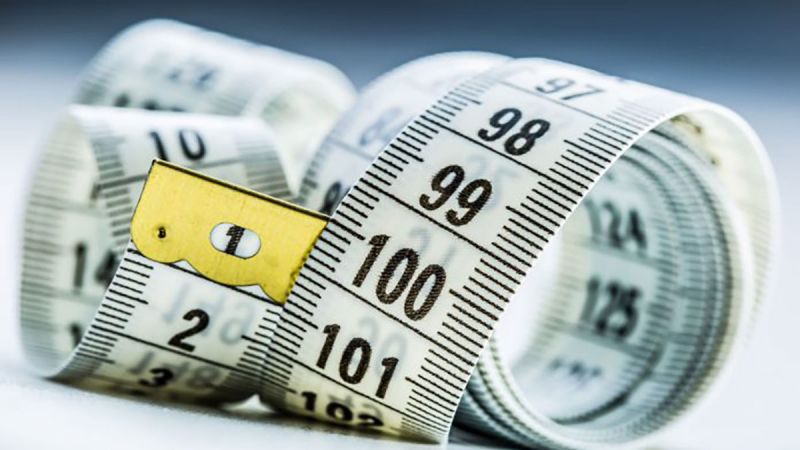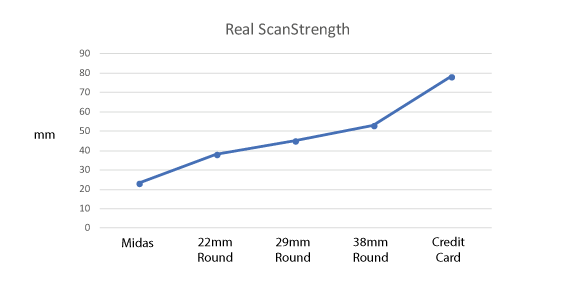
Simply, the larger the antenna on your NFC tag (label, disc tag, keyfob, etc) - the better the ScanStrength. Smaller antennas need a more accurate phone placement and require the phone to be closer. Larger antennas allow the phone to scan from a greater distance.
This article discusses the available sizes and the benefits.
NFC labels (white stickers, clear stickers and wet inlays) are available in a wide variety of sizes. The smallest stickers can be just 5-6mm square. The largest is typically about the size of a credit card at around 85mm x 55mm. How they perform is dependent on a number of factors - not least how well the tags are made.
Choosing which size is right for you will always come down to your particular application. As a general guideline where the tags are going to be scanned with a mobile phone consider the following points :
Fundamentally, there's no point including tags in your application unless everyone can scan them. The better the scan performance, the better the results. Apart from a small extra in additional shipping weight cost, there's rarely much price difference between smaller tags and larger tags.
In short, use the largest tag you can but don't go bigger than a credit card.
Seritag often get asked whether there is a performance difference between the white, clear and wet inlay variants. There isn't. For example, our 29mm white, clear, wet inlay and wet inlay (Type R) all contain exactly the same antenna and will scan in the same way. The difference is structural (see our NFC label formats article) and aesthetic only.
The same rules apply to disc tags as they do for labels - use the largest tags you can. Disc tags usually contain a different type of antenna and use a coil instead of an aluminium etching, but the principle is the same.
However, unlike labels, there can be an increase in price as the sizes get larger. Additionally, disc tags are often designed for use on metal surfaces and on-metal tags have a much smaller optimum size for scan distances.
As discussed above, ultimately it's the antenna size rather than the physical tag size that's important. With disc tags, this can be a little more complicated as technically, it's the antenna length that matters most. As disc tag antennas can be coils of wire, they can have a longer antenna for the size and therefore two identical size of antenna can perform quite differently (regardless of the quality of tuning, manufacture, etc).
When looking at disc tags, it's often useful to consider the antenna type as a 25mm coil antenna will often perform better than a 25mm etched aluminium antenna because of the length rather than diameter.
However.. it's also the case that disc tags often have a larger margin than labels so the antenna size relative to tag size can be a lot greater. For example, a 29mm can have a 27mm antenna. A 30mm disc tag may only have a 23 or 24mm antenna. So the gains made in using a coil can be offset becuase of the larger margin requirement.
Overall, the considerations are :
Put simply, for mobile phone use in closer proximity such as packaging or products, Seritag recommend a 29/30mm or 38/40mm label (typically a 25mm or 35mm antenna) or a 30-34mm disc tag as the best options.
The larger 48x78mm sized labels do perform better on a number of mobile phones but they are often slightly more expensive. We usually recommend 48x78mm labels for smart posters, bus stops, shelf wobblers and situations where the user might not get easily in reach of the tag.
An NFC tag is an antenna and chip encased in or stuck to plastic. Due to manufacturing tolerances, the size of that plastic support disc will be larger than the size of the antenna - you will have a border.
The size of that border is typically dependent on the quality of the manufacturing process and the skill of the manufacturer. If they aren't very good and have poor machinery, then they will increase the tolerance (size of the border) to make sure the antenna is always inside the cut of the sticker circle.
If they are good and they know what they are doing, then the machines place the antenna (or die cut) with more accuracy. This means a high quality tag is likely to have a larger antenna size for a given size of tag.
This is important. There's usually no benefit using a 38mm sticker if the antenna is just 25mm. The key here is to know the size of the antenna as well as the size of the sticker. For all out stickers, we list the size of the antenna alongside the size of the label itself.
ScanStrength is a system created by the Seritag team to make it easier to understand the comparative difference between tag performance. As the actual scan distance will vary a lot between mobile phones, we originally created a relative scale, which we called ScanStrength. This gave a very good indication of how one tag can be expected to perform in comparison with another.
Later in 2019, we launched the Real ScanStrength system which averages the scan performance of a selection of the the most popular mobile phones and provides the result as an actual mm value.
ScanStrength (or scan strength) is important because it relates to how easy a tag is scan. It's essentially how close the mobile phone needs to be to the tag before the tag will respond. A strong ScanStrength is important in any situation but understanding the differences will help understand which tag to choose.
For instances where the user is expected to be in close proximity - for example where they might be scanning the box of a product - then a low ScanStrength is usually adequate.
In instances where the user may be further away - such as a smart poster - then the very highest ScanStrength is important.
You can see from the graph below that difference in the relative scan strength of the different antenna sizes. Again, remember that this is the size of the antenna not of the overall tag itself.
There is a substantial increase from the size of a Midas tag (12mm x 19mm sticker size, 10mm x 17mm antenna size) to a 29mm round sticker size (25mm antenna). In fact, you might expect to be able to scan the tag from twice the distance.

For general mobile phone use cases, anything over 30mm will provide a good performance and a good user experience. Most users tend to hold the phone extremely close or even touch. Unless you are using the tag behind a thick material, a distance of a few cm is likely to provide a perfectly good user experience.
We originally wrote this article back in 2014. At the time, the number of phones that had NFC was limited and no iPhone could scan an NFC tag. Technology has moved on, not just with the NFC chips in the tags but also in the phones. In the past, we might have recommended that you use a tag no larger than 40mm. There are now many phones that transmit enough power to get a good performance increase on tags much larger than this. To that extent, we would now consider that a 48x78mm label is large as you should go.
However, smaller tags such as a 29mm or a 38mm tag also provide a strong scan performance and if you don't have the space, you'll have no problems in the vast majority of use cases.




